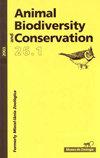Recommendations for the management of sarcoptic mange in free–ranging Iberian ibex populations
IF 1
4区 环境科学与生态学
Q3 BIODIVERSITY CONSERVATION
引用次数: 6
Abstract
In recent decades, sarcoptic mange has become the main driver of demographic changes in Iberian ibex (Capra pyrenaica) populations in the Iberian Peninsula. Given this species’ economic and ecological importance, priority must be given to management measures aimed at limiting the effects of this disease. However, despite the wealth of research on sarcoptic mange in ibex, no common patterns of action are yet available to manage this disease under field conditions. The lack of national and international protocols aimed at controlling sarcoptic mange has favoured the spontaneous emergence of various disease management initiatives in Spain. However, very little information is available concerning this trend and what there is tends to be available only as ‘grey literature’ or is consigned to the memory of local observers. Traditional strategies designed to combat this disease include the administration of medicated feed and the non–selective culling of mangy ibex. Here, we propose a management approach that takes into account aspects relating to the ecology and conservation of ibex populations, as well as public–health–related factors. Our recommendations are based on knowledge of the disease and host–parasite interaction, and aim to promote long–term advances in its control. Moreover, we discuss the efficacy of the measures traditionally used in mange management. The overall aim is to encourage debate between wildlife managers and motivate the development of alternative management strategies.对自由放养的伊比利亚野山羊种群中病管理的建议
近几十年来,疥虫管理已成为伊比利亚半岛伊比利亚野山羊(Capra pyrenaica)种群人口变化的主要驱动力。鉴于该物种的经济和生态重要性,必须优先考虑旨在限制该疾病影响的管理措施。然而,尽管对野山羊的病管理进行了大量的研究,但还没有在野外条件下管理这种疾病的共同行动模式。由于缺乏旨在控制疥疮管理的国家和国际议定书,这有利于西班牙自发出现各种疾病管理举措。然而,关于这一趋势的信息很少,而且往往只能作为“灰色文献”或寄托在当地观察者的记忆中。防治这种疾病的传统策略包括施用药物饲料和非选择性扑杀许多野山羊。在此,我们提出了一种管理方法,考虑到与野生山羊种群的生态和保护有关的方面,以及与公共卫生有关的因素。我们的建议是基于对该病和宿主-寄生虫相互作用的了解,旨在促进其控制方面的长期进展。此外,我们还讨论了传统管理中使用的措施的有效性。总体目标是鼓励野生动物管理人员之间的辩论,并激励开发替代管理策略。
本文章由计算机程序翻译,如有差异,请以英文原文为准。
求助全文
约1分钟内获得全文
求助全文
来源期刊

Animal Biodiversity and Conservation
农林科学-动物学
CiteScore
2.00
自引率
0.00%
发文量
21
审稿时长
>12 weeks
期刊介绍:
Animal Biodiversity and Conservation (antes Miscel·lània Zoològica) es una revista interdisciplinar, publicada desde 1958 por el Museu de Ciències Naturals de Barcelona. Incluye artículos de investigación empírica y teórica en todas las áreas de la zoología (sistemática, taxonomía, morfología, biogeografía, ecología, etología, fisiología y genética) procedentes de todas las regiones del mundo. La revista presta especial interés a los estudios que planteen un problema nuevo o introduzcan un tema nuevo, con hipòtesis y prediccions claras, y a los trabajos que de una manera u otra tengan relevancia en la biología de la conservación. No se publicaran artículos puramente descriptivos, o artículos faunísticos o corológicos en los que se describa la distribución en el espacio o en el tiempo de los organismes zoológicos.
 求助内容:
求助内容: 应助结果提醒方式:
应助结果提醒方式:


